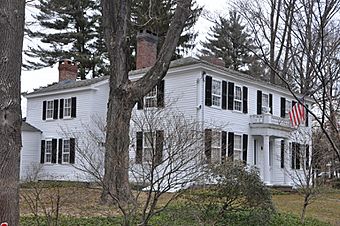Abbot-Battles House facts for kids
Quick facts for kids |
|
|
Abbot-Battles House
|
|
 |
|
| Location | 31 Lowell St., Andover, Massachusetts |
|---|---|
| Built | 1809 |
| Architectural style | Federal |
| MPS | Town of Andover MRA |
| NRHP reference No. | 82001905 |
| Added to NRHP | June 10, 1982 |
The Abbot-Battles House is a special old house in Andover, Massachusetts. It was built around 1809. At first, it was a farmhouse for a family named Abbot, who were well-known in the area. This house is a great example of a style called Federal architecture, which was popular when the United States was still quite new. Later, some parts were added in a Victorian style. Because of its history and unique design, the house was added to the National Register of Historic Places in 1982. This means it's officially recognized as an important historical building.
About the Abbot-Battles House
The Abbot-Battles House stands just north of downtown Andover. You can find it on the north side of Lowell Street, which is a busy road. It's a two-story house made of wood. It has a gently sloping roof and its outside walls are covered with overlapping wooden boards called clapboards.
What Does It Look Like?
The front of the house is wide, with five sections. The main door is in the middle. A porch from the Victorian era covers the entrance. This porch has tall, fancy columns called Ionic columns. These columns support a decorated beam above them. The porch roof also has a railing with decorative urns on its posts.
A Look at Its History
The house was built around 1809 for Jeduthan Abbot. He was a farmer who had gotten married a few years earlier and had two children. Interestingly, parts of an even older house, built around 1700, were used to help build this one. The beautiful Federal style front of the house was added during Jeduthan Abbot's time.
In 1838, Jeduthan Abbot sold the house to his son. But soon after, it was sold to Winslow Battles, who worked as a machinist (someone who builds or repairs machines). The Battles family owned the house for a long time, until 1950. The story of who owned this house shows how Andover changed over time. It went from being a town mostly about farming to one with more factories and industries.



